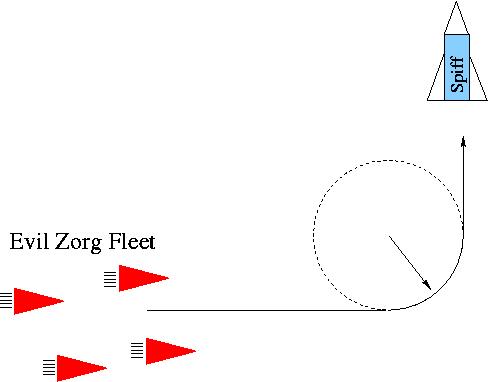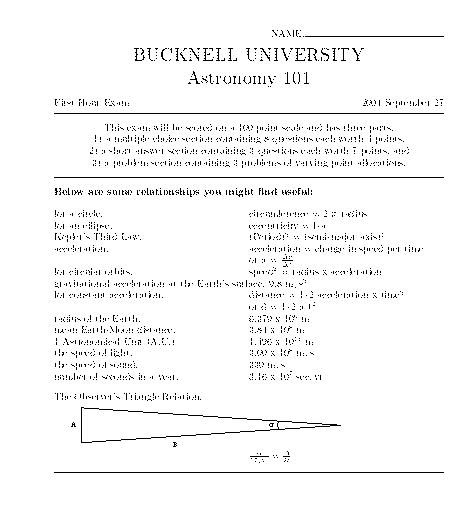In Class:
Question to Ponder
In a desperate attempt to elude the evil Zorg Fleet, Spaceman Spiff
deftly execuates a tight left hand turn.

During his turn, his craft
briefly follows a circular path whose radius is 10 m. If his speed is
30 m/s through the turn, what is the acceleration he (and his
spacecraft) feels?
- a) zero
- b) 30 m/s/s
- c) 60 m/s/s
- d) 90 m/s/s
- e) 120 m/s/s
Newton Tests the Strength of Gravity Over Distance
But Will This Work for Earth Gravity, Too?
- Newton reasons that he can test whether the gravity responsible
for keeping you and me stuck to the Earth is the same gravity that's
keeping the Moon in orbit.
- The Earth's surface is 6.38 x 106 m from its center.
- The Moon is 3.84 x 108 m from the center of the Earth.
- If the inverse square law holds for Earth gravity, too, then the
acceleration felt by the Moon must be weaker than that felt here at
the surface of the Earth by a factor of (6.38 x 106 m /
3.84 x 108 m)2 = (1/60)2 = 1/3600.
- Well 1/3600th of 9.8 m/s2 is 2.7 x
10-3 m/s2 --- just what Newton measured for the
acceleration that the Moon feels in its circular orbit!
- Therefore the inverse square law works for the Sun's influence on
the planets and the Earth's influence on the Moon.
- It's a universal law of gravitation -- one that applies
in both the celestial and terrestrial domains.
Mass as the Source of Gravity
- Newton further postulates that mass is the source of
gravity.
- The larger the mass, the stronger the gravity (all else being
equal).
- His universal gravitation law now states:
acceleration due to gravity = a = GM/r2
where G is Newton's gravitational constant = 6.67 x 10-11
m3 / s2 kg, and M is the mass of the object
creating the gravity.
Measuring the Mass of an Object Dynamically
- Using Newton's gravity law and what we know about circular
orbits, we can measure the mass of planets or other objects.
- First, put something in orbit around the planet (e.g., a moon, or
an artificial satellite).
- Measure the radius of the satellite's orbit and its speed.
- Use a = v2/r to determine the acceleration it must
feel.
- We know that this acceleration must also be equal to the
acceleration caused by the gravity of the planet.
- Therefore, a = v2/r = GM/r2
and M = v2 r/G.
|
![]()

